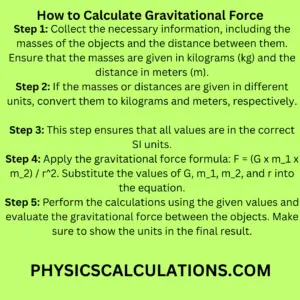What is Gravitational Force?
Definition: Gravitational force is directly proportional to the product of the two masses and inversely proportional to the square of the distance between them. Additionally, gravitational force, also known as gravity, is the force of attraction between two objects with mass.
Gravitational force explains the force of attraction between two objects with mass. It is the force responsible for keeping planets in orbit around the sun and objects grounded on the Earth’s surface. Knowing how to calculate gravitational force is important in the field of science. In this article, I will cover the principles behind gravitational force and provide a step-by-step guide on how to calculate it.
The magnitude of this force depends on the masses of the objects and the distance between them. According to Isaac Newton’s Law of Universal Gravitation, every particle of matter in the universe attracts every other particle with a force directly proportional to the product of their masses and inversely proportional to the square of the distance between their centres.
Newton’s Law of Universal Gravitation
Newton’s Law of Universal Gravitation states that the gravitational force between two objects is given by the formula:
F = (G x m1 x m2) / r2
Where:
- F is the gravitational force between the two objects
- G is the gravitational constant (approximately 6.67430 x 10^-11 N m^2/kg^2)
- m1 and m2 are the masses of the two objects
- r is the distance between the centres of the two objects
Calculating Gravitational Force: Step-by-Step Guide

To calculate the gravitational force between two objects, follow these steps:
Step 1: Gather Information
Collect the necessary information, including the masses of the objects and the distance between them. Ensure that the masses are given in kilograms (kg) and the distance in meters (m).
Step 2: Convert Units if Necessary
If the masses or distances are given in different units, convert them to kilograms and meters, respectively. This step ensures that all values are in the correct SI units.
Step 3: Use the Gravitational Force Formula
Apply the gravitational force formula: F = (G x m1 x m2) / r2. Substitute the values of G, m1, m2, and r into the equation.
Step 4: Calculate the Gravitational Force
Perform the calculations using the given values and evaluate the gravitational force between the objects. Make sure to show the units in the final result.
Examples of Gravitational Force Calculation
Let’s consider a few examples to illustrate how to calculate gravitational force.
Example 1: Calculating the Gravitational Force between Earth and a Satellite
- Mass of Earth (m1) = 5.97 x 1024 kg
- Mass of the satellite (m2) = 500 kg
- Distance between Earth and the satellite (r) = 6.7 x 106 m
Using the formula F = (G * m1 * m2) / r^2 and substituting the values:
F = (6.67430 x 10-11 Nm2kg-2 x 5.97 x 1024 kg x 500 kg) / (6.7 x 106 m)2
After performing the calculations, the gravitational force between Earth and the satellite is found to be approximately 272.95 N.
Example 2: Gravitational Force between Two Planets
- Mass of planet 1 (m1) = 2 x 1024 kg
- Mass of planet 2 (m2) = 3 x 1023 kg
- Distance between the centres of the planets (r) = 4 x 108 m
Applying the formula, we get:
F = (6.67430 x 10-11 Nm2kg-2 x 2 x 1024 kg x 3 x 1023 kg) / (4 x 108m)2
After calculation, the gravitational force between the two planets is approximately 2.5 x 108 N.
Factors Affecting Gravitational Force
Several factors affect the magnitude of the gravitational force between two objects:
- Mass: Greater mass leads to a stronger gravitational force.
- Distance: Increasing the distance between objects weakens the gravitational force.
- Gravitational Constant: The value of the gravitational constant determines the strength of the force.
Applications of Gravitational Force
Gravitational force plays a crucial role in various fields, including:
- Astronomy: Explaining celestial motions, orbits, and interactions between celestial bodies.
- Planetary Science: Studying planetary formation, structure, and dynamics.
- Engineering: Calculating forces in structures and designing systems involving gravitational interactions.
- Satellite Technology: Determining orbits and predicting satellite trajectories.
- Astrophysics: Knowledge of the behaviour of stars, galaxies, and the universe as a whole.
Conclusion
Gravitational force governs the interaction between objects with mass. When we learn how to calculate gravitational force using Newton’s Law of Universal Gravitation, we can unravel the mysteries of celestial motion and apply this knowledge in various scientific and technological fields.
FAQs
- What is gravitational force?
Gravitational force is the force of attraction between two objects with mass. It is responsible for keeping planets in orbit and objects grounded on Earth. - How does the gravitational force affect objects on Earth?
Gravitational force pulls objects toward the centre of the Earth, giving them weight and keeping them grounded. - Can gravitational force be negative?
No, the gravitational force is always positive. It is attractive in nature and cannot be negative. - Is gravitational force the same everywhere in the universe?
Gravitational force varies depending on the masses and distances involved. It is not the same everywhere in the universe. - How does distance affect gravitational force?
The gravitational force decreases with an increase in distance between two objects. It follows an inverse square relationship, meaning doubling the distance reduces the force to one-fourth of its original value.
You may also like to read: